Website translation: our guide to move fast and effectively
For a number of years now, we have been seeing web content production grow rapidly.
Ever more creative and varied, it also comes in several formats: more sophisticated and in-depth websites, blogs, social network use, audio-visual, etc. All of these approaches bring their share of challenges related to managing the translation of your content.
You have probably arrived here because you are interested in translation as a way to get closer to your audiences and customers around the world. You may even already have a website with two language versions, but want to take the next step and make it multilingual.
To improve your presence and relevance in your target markets, it is very important to adapt to languages spoken locally in these target markets.
Going beyond an English language version is vital given that 75% of consumers (CSA Research) prefer to buy from a website that provides information in their language.
However, there are many pitfalls to avoid, as creating a multilingual website is not as straightforward as it may seem, and the steps in implementation are critical!
So, in this article, you will find all our recommendations to effectively translate your website.

Tool No.1: Checklist, for effective preparation.
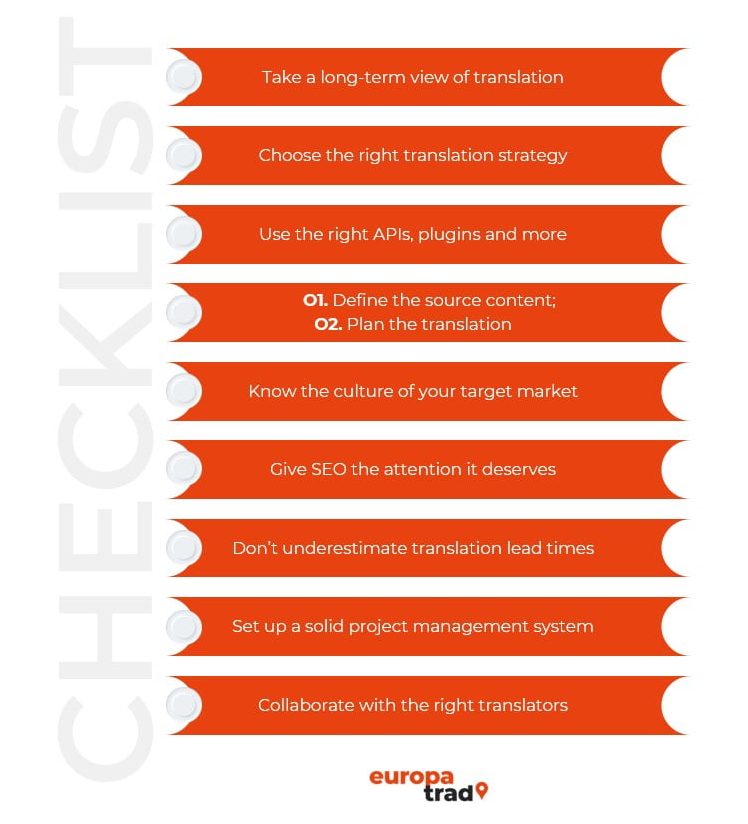
Get your notebook to the ready, as here is our checklist of key points for translation that we (strongly) recommend applying.
These points are essential from the outset – and throughout – your website translation project.
First, you need to:
- Think about translation and its development in the long-term and not only the initial translation (we will return to this point).
- Choose your approach: machine, human or hybrid.
- If you use a CMS, choose and use the right connectors and the right multilingual managers.
- Plan the translation once the source language texts have been clearly defined.
Next:
- Take into account the culture of the target audience and therefore “localize”.
It is not a good idea to translate exactly the same way in Dutch and Flemish, even though they are closely related languages.
The same applies for UK and US English.
What’s more, formats also differ. - Pay close attention to SEO, i.e. search engine optimization in target languages.
- Don’t underestimate the time required; translating large amounts of content can take time.
- Set up a robust project management system (we will explain why).
And, of course:
- Work with the right translators.
Prioritize for greater control: machine translation (MT) or human translation? A hybrid approach?
The fastest way to translate your website is to use MT. Various solutions are available that offer the ability to translate in a matter of minutes. However, while this may appear simple, it can be unproductive.
If you have a few pages and are fully competent in the target language, you can use free translation engines such as Google Translate, DeepL and Reverso), copy and paste, adapt and correct the translations yourself, and end up with translated pages.
On the other hand, if you have dozens of pages, in several languages that you are unfamiliar with, this can quickly lead to many hours of additional work. What’s more, there may be errors and mistranslations that harm your image among the very target audiences you are trying to win over.
No matter how tempting machine-based solutions may be, we believe in combining the right tools for multilingual website management, human translation and MT in a hybrid and prioritized approach, taking into account the levels of importance of your website content.
Prioritize the content of your website into three categories and apply a suitable level of translation to each:
1. Main content: this is essential and includes all pages with a high conversion rate; those that attract most traffic, like the homepage, a landing page with great commercial importance, user interfaces, sales and marketing presentations and regulatory documents.
The solution: These pages must absolutely be accurately translated.
We recommend that they are systematically translated by professional, native translators, with revision also carried out by linguists.
2. Secondary content: all pages where traffic and web performance aspects are less important.
These translations must be accurate, but may have stylistic inconsistencies (such as when idiomatic expressions are translated word for word from English to French).
The solution: These texts may be translated using machine translation as a basis, with fast, but qualified revision (post-editing), performed by an experienced, native translator.
3. “High-volume” content: of no direct importance, but essential for natural referencing on Google.
This often includes text used to respond to long-tail searches.
The solution: This task may be performed by machine translation.
Human intervention will, however, be necessary to select, implement and configure translation engines, using your terminology, glossaries and any translation memories you may have. This will ensure that the pages provide satisfactory readability for people browsing them.
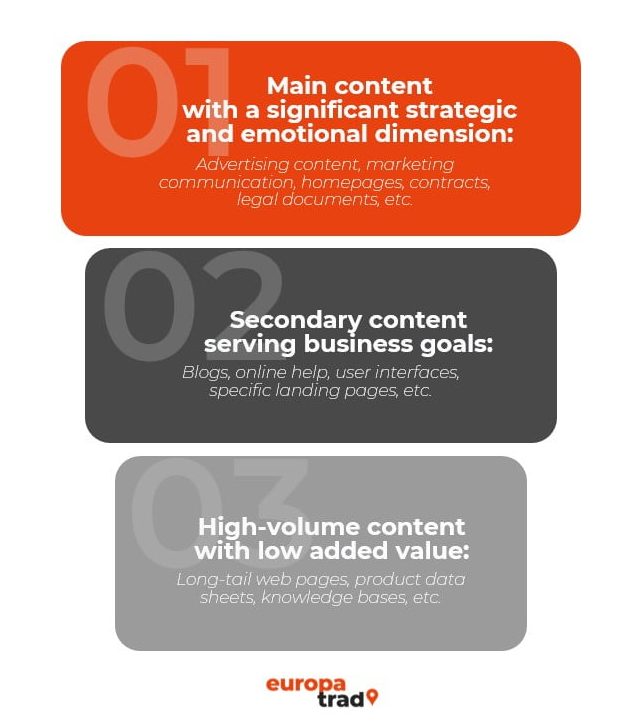
MT as a support tool
Bear in mind that when using free access MT engines like Google Translate, or MT services alone, you will have no guarantee of quality for the translation.
There will be a risk of mistranslations in the text, as well as a serious lack of suitability for the context of countries you are targeting, creating pages with little value.
This is exactly what you want to avoid!
Here are some examples we found on websites translated entirely by AI (in this case, Google Translate):


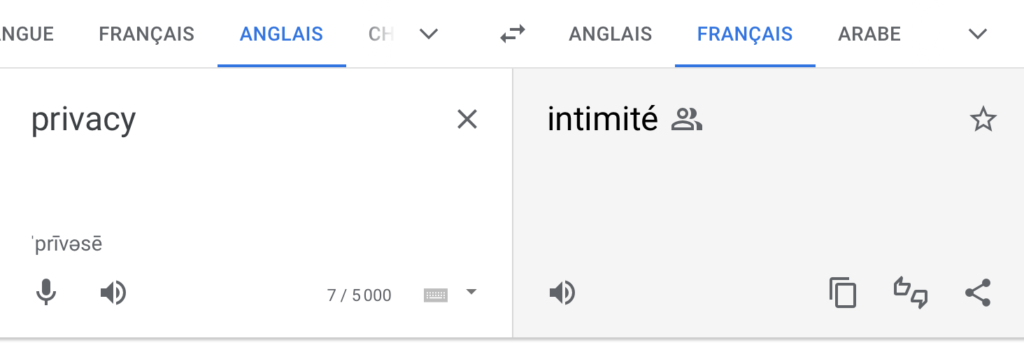
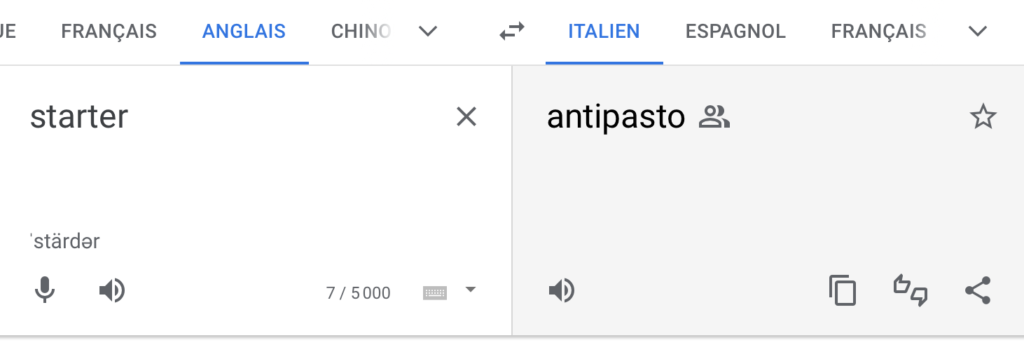
The word ‘privacy’, as in ‘privacy policy’, translated as ‘intimité’ (intimacy) in French; ‘cookies’, as in ‘online cookies’, translated as ‘biscuits’ in French and ‘galletas’ in Spanish; and ‘starter’, as in ‘starter pack’, translated to mean a ‘starter course’ in Italian.
Errors such as these can be found in all languages, even German, which is fairly closely related to English.
Build translation with a long-term view
It is important to bear in mind that, while it may be tempting to reduce your spending on marketing by using online MT engines, or plug-in tools that can automatically translate an entire website, experience shows that these AI-based solutions rarely produce a satisfactory result.
They are counter-productive, particularly for pages with a high conversion rate! While you will be able to translate large amounts the result will lack relevance.
Worse still, you may end up with a costly mistranslation that harms your brand and loses you many customers. There are many, often comical, examples. Nothing can replace the writing ability and idiomatic feel of a human translator.
Now, go back to the very first point of your checklist.
That’s right, the one where we recommend taking a long-term view of translation and its development and not only focussing on the initial translation.
Our three categories represent the most effective initial translation strategy, in our view, since it makes it possible to adapt to your needs and your budget. It is true that translation budgets can be significant, particularly when we are tempted to increase the depth of a website and quantities published to improve natural referencing or specifically target individual customer segments. This budget is then multiplied further each time you add a language. One way around this is to spread your translation spending out over time.
Based on this three-tier approach, you can build the translation of your website over time. This ties in with our advice to take a long-term view.
Secondary and “ high-volume content” can be improved post-translation, through revision by native, professional translators, to improve its quality.
Here is a little tip for when you are planning the tree structure: if you create your website using a visual website planner like Octopus, which defines your wireframes, you can build the website tree structure and, at the same time, the translation hierarchy. Octopus enables the use of colour codes to better visualize your premium, secondary and “high-volume” pages. This is perfect to plan for the future development of your translations!
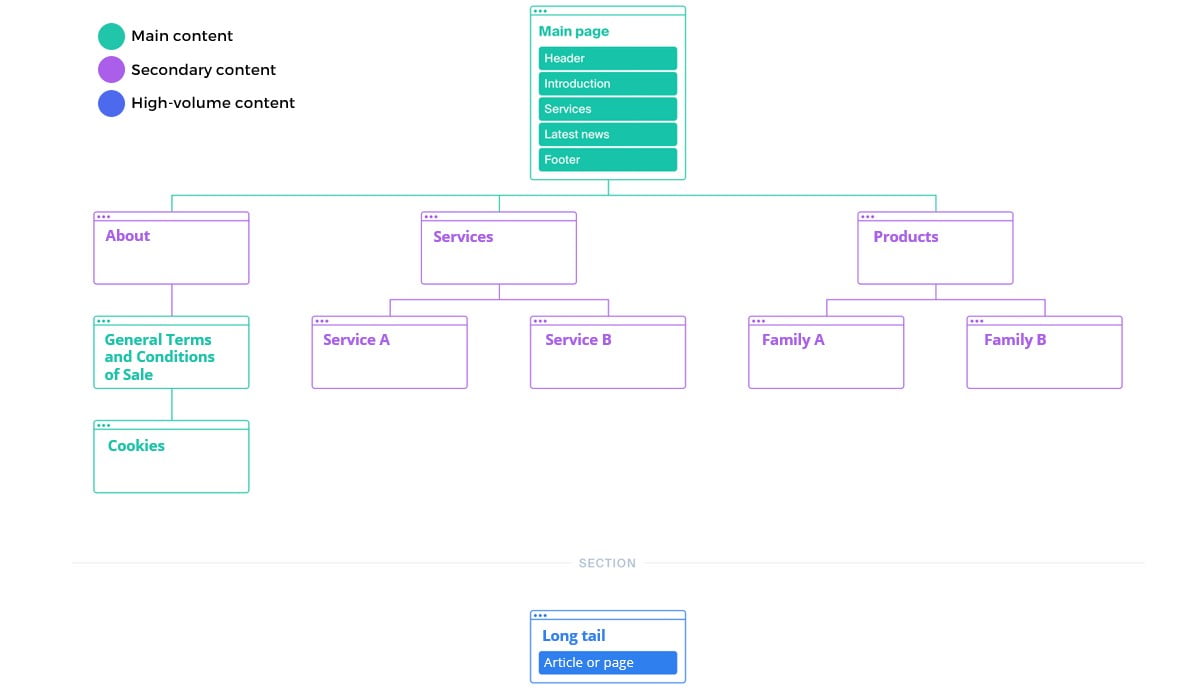
So far, so good?
OK, now it’s time to cover the more technical aspects of website translation!
Know the different approaches to website translation
01
A website with just a few pages
To translate a website with a handful of pages, there is no point looking for a complicated or overly automated method. Once you have written, or even published, your website in the source language, you can duplicate the pages in the target language and then replace the source texts with the translations.
Most of the time, it will even be simpler to work in a text editor and then reintegrate them.
If you don’t master the target language, you can call on the services of one or more native translators or a language service provider, sending them the files in text format and then reintegrating them, while ensuring the pages are correctly interlinked.
02
A website developed with a CMS
Most websites are developed using CMS (Content Management Systems) that help to organize content into “blocks” and improve the presentation, while managing SEO-related aspects and additional publications.
The CMS that almost everyone has heard of is WordPress. However, other CMS solutions are making regular progress.
WordPress was not designed at the outset to manage languages. It does not directly integrate management of multilingual page duplication and translation of text content. Users therefore need to select an extension that makes it possible to manage multilingual content and organize translations. This choice requires care as it could both save you a lot of time and waste a lot of your time.
The most well-known extensions for WordPress are Polylang and WPML. We recommend using WPML (WordPress Multi Language), which offers many advantages.
It makes it easy to create page templates for translation and language selectors, as well as manage translation orders and metadata translation. Above all, it makes it very easy to use professional translation tools and collaborate with translation companies. By using it, you can integrate best practices in your translation workflow, which help you capitalize on all previously translated content.
This means you can optimize translations throughout your website and make it easier to perform updates.
An important point to bear in mind: even though WPML offers many online resources, it is advisable to turn to people with experience for the initial configuration, to avoid overlooking any text or strings for translation (such as metadata and buttons) and ensure that the settings are compatible with all browsers (including Chrome, Safari, Firefox and Edge). The WordPress version you are using must also be taken into account.
03
CMS + multilingual product catalogue integration
Increasingly, B2B websites are integrating full product catalogues, without necessarily including an e-commerce component.
An accurate translation of these product catalogues is crucial.
The catalogue section of such websites is managed by a suitable PIMS (Product Information Management Systems). Translation of product catalogues therefore involves managing translation from the PIMS by connecting it to translation management tools, or by exporting/importing the structured product files for translation. Accurate configuration and use of translation tools ensure that translations are consistent and coherent as product descriptions are often very similar. It is also important to avoid errors in numbers by using suitable quality control tools.
Beyond product data sheets, CMS-related aspects and the translation of editorial content are carried out as described above.
04
E-commerce websites
Most e-commerce websites are based on natively multilingual tools, like Prestashop and Shopify.
In this case, the challenge is to separately translate both the editorial content and product data sheets. You also need to adapt the pre-translated interfaces of these multilingual tools.
Shopify, for example, with Shopify Markets, offers comprehensive solutions for the localisation of e-shops.
Interfaces are automatically localized on request (including measurements, currencies and conversion channels).
However, content that is specific to your brand, products and e-shop must be translated and adapted. When it comes to these, the simplest solution is to export them in CSV format, translate them and then import them back in.
As with the translation of multilingual catalogues, the translation of product data sheets in an e-shop will strongly benefit from the use of professional translation tools if you entrust translations to a specialized agency. These tools make it possible to systematically reuse approved translations and offer benefits in all areas: cost, speed and coherency.
Collaborate effectively with your web developers and digital services provider
The relationship with your partners
If you have entrusted a digital services provider with the development of your website, it needs to fully understand how the website will be translated, and which tools and technologies will be used for this purpose. If there is not a thorough technical assessment and close coordination from the outset, there is a risk that the translation management process becomes overly complex. This can extend lead times and inflate the budget.
Together, the aim is to organize and plan website production and translation (localization), according to specific solutions, taking the following into account: objectives; the expected level of translation quality; website creation, translation and maintenance methods; the operational schedule as well as monitoring of production and SEO performance in all languages (by searching for and adapting keywords from the source to the target language).
By working with a professional translation agency, you benefit from access to quality project management and experts in this field, who also fully understand your business sectors. Also, this facilitates translation in the long-term through the creation and use of translation memories.
Planning how translation will be managed therefore enables greater control of its implementation, as well as your budget and deadlines. Particularly if you have highly developed content, the level of translation quality will be differentiated from page to page.
Speaking of deadlines…
Your schedule
While translation comes in during the final stages of your website creation project, you need to plan ahead for it, give it the attention it deserves and take into account turnaround times.
So, one of the critical points of project management is to stick firmly to the set schedule agreed to between the parties beforehand. The time needed for translation cannot be compressed and it must be taken into account when planning your online publication date. Spending some time looking at implementation methods will help avoid making hurried technology choices at the last minute.
When devising the strategy, it can be tempting to put off planning some translations that seem less important.
However, bear in mind that translation omissions that need to be corrected later on often lead to wasted time and money: wasted time for the agency and money for you, because constant back-and-forths increase time spent working on the project and related management costs. They get in the way of bringing your website and its translated content online.
Lack of a thorough needs analysis at the start of the project, combined with poor configuration, will significantly increase the risk of overlooking content.